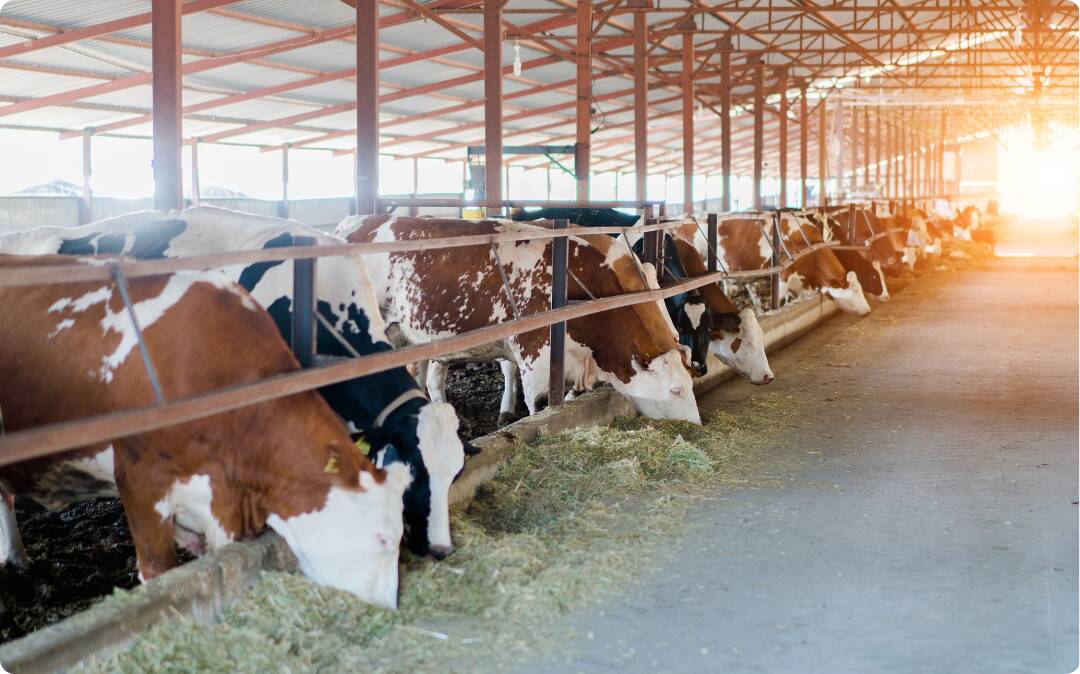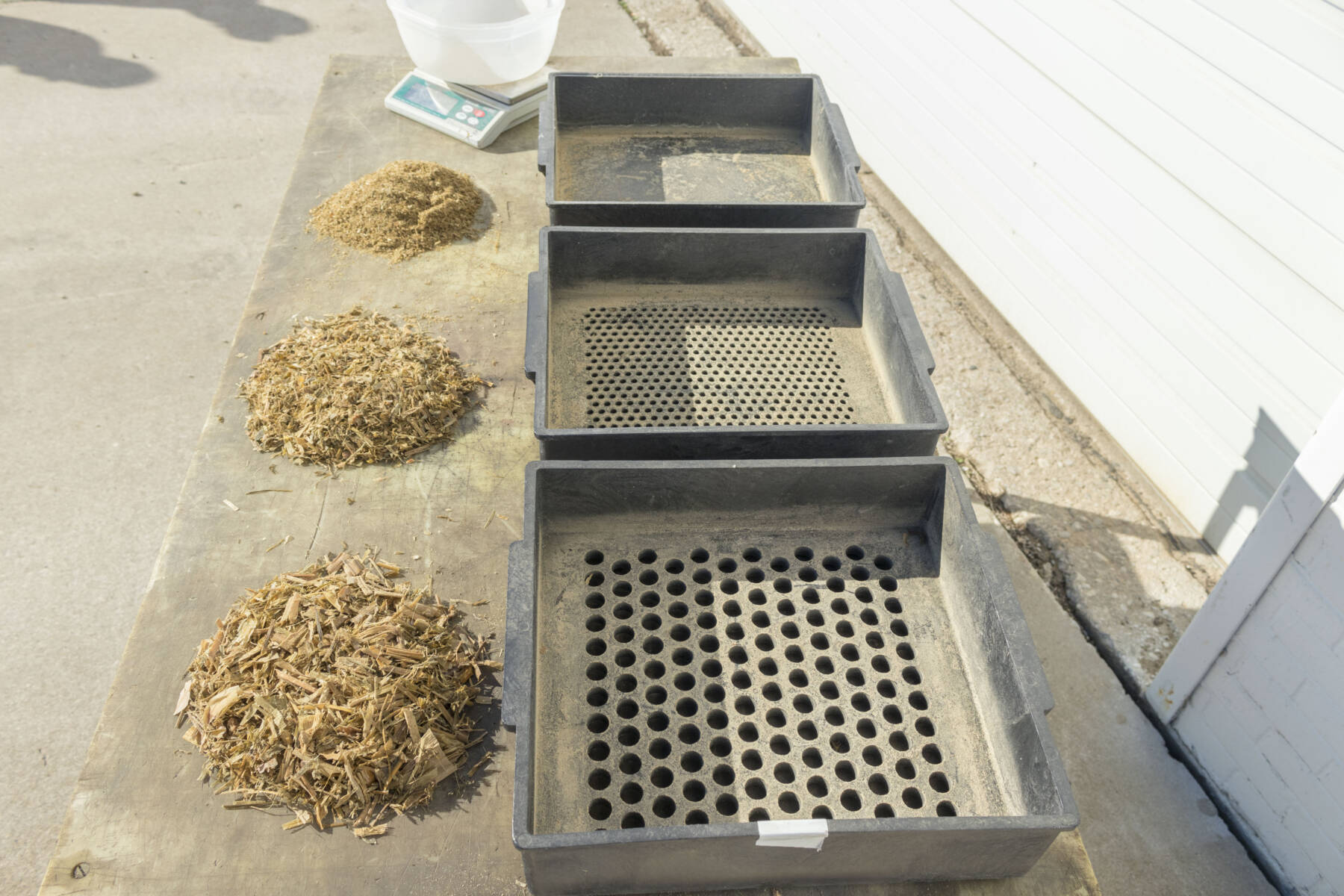
Feed-Pad Management Essentials:
Optimizing Feed Storage and Distribution for Enhanced Livestock Nutrition
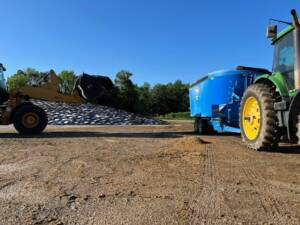 Feed-pad management is an essential aspect of modern dairy farming. It plays a crucial role in ensuring that animals receive high-quality nutrition while optimizing operational efficiency and safety. In this blog, we will explore the key components of feed-pad management, including planning and laying out your fresh feed storage, the pros and cons of piling versus bagging, and how the feed pad affects mixer loading and feeding.
Feed-pad management is an essential aspect of modern dairy farming. It plays a crucial role in ensuring that animals receive high-quality nutrition while optimizing operational efficiency and safety. In this blog, we will explore the key components of feed-pad management, including planning and laying out your fresh feed storage, the pros and cons of piling versus bagging, and how the feed pad affects mixer loading and feeding.
Planning Your Fresh Feed Storage Layout: The Foundation of Efficiency
The foundation of efficient feed-pad management starts with strategic planning and layout of your fresh feed storage. A well-organized feed storage system maintains feed quality, minimizes waste, ensures that your livestock receives consistent, high-quality feed, and optimizes operations. It affects everything from labor costs to feed quality. Here are some tips for planning and laying out your feed storage:
Location & Traffic Flow: When planning your feed-pad layout, consider traffic flow first. Select a location that is easily accessible for both delivery trucks, loaders and feeding equipment. They should all have clear, unobstructed paths that minimize backing up and tight turns. This reduces the time and labor required for loading and transporting feed to the animals. In addition to traffic flow, study the environment. Take into consideration prevailing wind directions to minimize dust and odors affecting nearby areas as well as potential contamination sources. The ideal layout has dedicated entry and exits points and facilitates smooth vehicular movement, reducing the risk of accidents and ensuring efficient operation.
- Size and Capacity: Size your pad according to your operation’s needs. Ensure there is enough space for
 expansion and future needs. For most farms, allocating at least 20-30 feet of width for each commodity bay provides adequate space for equipment maneuvering. Remember that under sizing your feed-pad often creates more long-term problems than oversizing it.
expansion and future needs. For most farms, allocating at least 20-30 feet of width for each commodity bay provides adequate space for equipment maneuvering. Remember that under sizing your feed-pad often creates more long-term problems than oversizing it. - Design, Drainage, & Ventilation: Implement a design that facilitates easy access and prevents contamination. Elevated storage platforms and covered structures are effective in protecting feed from weather elements and pests. A concrete or asphalt surface is recommended for durability and ease of cleaning. To prevent water accumulation and spoilage, install proper drainage systems.
The design of the feed-pad area should focus on easy access and quality, healthy feed. To prevent or minimize contamination of feed, take into account drainage and ventilation. Without good ventilation, moisture can buildup and lead to spoilage and mold growth. Drainage is another key consideration. Your feed-pad should have a 1-2% slope away from feed storage areas to prevent water pooling, which can lead to feed spoilage and equipment issues. Proper drainage also helps maintain the structural integrity of your pad.
Storage Options: Piling vs. Bagging
Choosing the right storage method for fresh feed is essential for maintaining its quality and nutritional value. Let’s look at the pros and cons of piling and bagging storage options:
Piling
Piling feed on a well-constructed pad offers several advantages: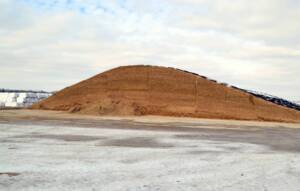
- Cost-Effective: Piling is generally less expensive as it requires fewer materials and labor compared to bagging.
- Ease of Access: Feed is readily accessible, allowing for quick loading and unloading. Ideal for large-scale operations.
- Scalability: Easily expand or reduce the pile size based on seasonal demand.
- Flexibility: Piling is versatile and can accommodate varying quantities of feed without the need for precise measurements. You can visually see available feed quantities at a glance.
The challenges of piling are:
- Weather Elements: Exposed piles are vulnerable to weather elements, which can lead to spoilage, especially on the outer layers. This exposure often results in higher dry matter losses compared to other storage methods.
- Careful Management: Attention is required to maintain a clean face and minimize oxygen exposure throughout the feeding process.
Bagging
The advantages of feed bagging are:
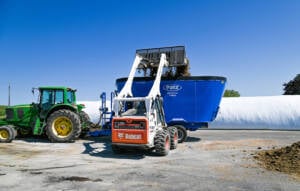
- Protection from Elements: Bags offer better protection against weather conditions, moisture, and pests. When bags are sealed properly, exposure to contaminants and pests are reduced. You can expect significantly reduced spoilage and dry matter preservation.
- Portion Control: Bagging helps in managing feedportions precisely, minimizing waste.
- Inventory Management: Bagging allows for precise tracking of feed quantities, reducing the risk of over or underfeeding.
The challenges of bagging are:
- Upfront Costs: Expect higher upfront costs for equipment and plastic.
- Planning: Bags require more planning regarding placement and access, as they cannot be easily moved once filled.
- Space: Space requirements can be substantial, as bags require more square feet per ton and need to be placed in areas where they won’t be damaged by equipment traffic.
Impact on Mixer Loading and Feeding
The design and management of a feed-pad significantly influences mixer loading efficiency and the feeding process:
- Loading Efficiency: A well-organized feed-pad ensures there is ample space for maneuvering mixers and loaders, reducing the risk of accidents and equipment damage. A well thought out design gives easy access to feed, reducing the time and labor required for loading mixers. Clear pathways and strategically placed feed storage minimize delays.
The orientation of feed piles or bags relative to your mixing area can save significant time during daily operations. Ideally, your highest-use ingredients should be positioned closest to the mixing area to minimize loader travel distance.
Surface quality matters for equipment performance and longevity. A smooth, durable concrete surface reduces wear and tear on equipment tires and undercarriages while allowing for cleaner feed pickup with less contamination from the ground.
Consider implementing clearly marked loading sequences and ingredient locations. This organization helps ensure accurate ration mixing, particularly when multiple people may be operating loading equipment. Consistent placement of ingredients reduces errors and improves feeding accuracy.
- Herd Health: Proper feed-pad management minimizes contamination and spoilage, ensuring consistent feed quality. This is crucial for maintaining animal health and productivity.
Safety Considerations
Be smart and work safe. Creating a safe environment for employees and animals is paramount:
- Lighting: Ensure adequate lighting for early morning or evening work, which is common during busy seasons. Proper illumination reduces accidents and improves work quality.
- Clear sight lines: Maintain clear sight lines throughout your feed-pad area. Blind corners and obstructed views create hazardous conditions when multiple pieces of equipment are operating simultaneously.
- Standard Operating Procedures: Establish and enforce standard operating procedures for all feed-pad activities. These should include equipment inspection protocols, proper loading techniques, and communication standards when multiple operators are working in the same area.
- Weather: Weather considerations should also factor into your safety planning. Snow removal plans, ice management, and wet weather protocols help maintain safe operations year-round.
- Personal Protective Equipment (PPE): Enforce the use of appropriate PPE to ensure visibility to operators and protect against potential hazards, such as reflective safety vests, gloves, masks, and safety boots.
- Emergency Procedures: Develop and communicate emergency response plans for accidents or feed contamination incidents.
Conclusion
Effective feed-pad management is the cornerstone of successful agricultural operations. By carefully planning your feed storage layout, weighing the benefits of piling versus bagging, and optimizing for mixer loading, you can enhance your farm’s productivity, reduce labor costs, and improve feed quality and consistency. Remember, a well-maintained feed pad not only boosts operational efficiency but also contributes to a safer and more sustainable farming environment.
For equipment solutions that can help you maximize your feed handling efficiency, contact Patz Corporation at 920-897-2251 or visit patzcorp.com.

 Location & Traffic Flow: When planning your feed-pad layout, consider traffic flow first. Select a location that is easily accessible for both delivery trucks, loaders and feeding equipment. They should all have clear, unobstructed paths that minimize backing up and tight turns. This reduces the time and labor required for loading and transporting feed to the animals. In addition to traffic flow, study the environment. Take into consideration prevailing wind directions to minimize dust and odors affecting nearby areas as well as potential contamination sources. The ideal layout has dedicated entry and exits points and facilitates smooth vehicular movement, reducing the risk of accidents and ensuring efficient operation.
Location & Traffic Flow: When planning your feed-pad layout, consider traffic flow first. Select a location that is easily accessible for both delivery trucks, loaders and feeding equipment. They should all have clear, unobstructed paths that minimize backing up and tight turns. This reduces the time and labor required for loading and transporting feed to the animals. In addition to traffic flow, study the environment. Take into consideration prevailing wind directions to minimize dust and odors affecting nearby areas as well as potential contamination sources. The ideal layout has dedicated entry and exits points and facilitates smooth vehicular movement, reducing the risk of accidents and ensuring efficient operation.
